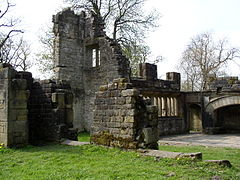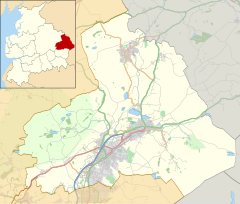Wycoller Hall
| Wycoller Hall | |
|---|---|

The remains of the great hall.
|
|
|
Location within the Borough of Pendle
|
|
| General information | |
| Town or city | Wycoller, Lancashire |
| Country | England |
| Coordinates | 53°50′57″N 2°06′14″W / 53.8491°N 2.1038°W |
| Construction started | Mid sixteenth century |
| Completed | 1596 |
|
Listed Building – Grade II*
|
|
| Official name | Remains of Wycoller Hall, including boundary wall to river |
| Designated | 23 April 1952 |
| Reference no. | 1073331 |
| Official name | Wycoller Hall |
| Reference no. | 1003130 |
Wycoller Hall was a late sixteenth century manor house in the village of Wycoller, Lancashire, England. The hall was the centre of a sizable estate but subsequently fell into disrepair. The ruins are now listed, and form part of Wycoller Country Park.
Wycoller Hall dates back to the end of the 16th century, and was built upon the site of a house occupied in 1507 by Piers Hartley. By the 1590s a substantial house had been built, probably sometime in the mid 16th century, replacing Piers' original dwelling. The estate then came into the possession of the Cunliffe family, after the marriage of Pier's daughter Elizabeth to Nicholas Cunliffe in 1611. They had a number of children, one of whom, John, married Grace Hartley in 1628. The Cunliffes settled at Wycoller in the 1720s, after losing their ancestral home to debts. The estate then passed through several brothers, all of whom died without issue, before passing to the grandson of one of the sisters, Henry Owen, on the condition that Owen took the name Cunliffe. He took the name Henry Owen Cunliffe, and became the new squire. He embarked on a large building project for the hall, to create a home that he felt would be worthy of his position, and that would attract a new wife.
The building project took over a year to complete, during which time Henry moved out and lodged at the nearby public house. The work included the fitting of a new porch, a large range of mullioned windows, and the modernisation of the interiors. By the time it was complete Henry had married and the couple moved into the hall to enjoy their new lifestyle. Henry was however a keen sportsman and gambler, and ran up heavy debts. On his death in 1818 the property passed to his nephew, Charles Cunliffe Owen, but Charles could not afford to pay off the debts, and the estate was parcelled off to the creditors. The hall passed to a distant relative, John Oldham, and then to the Rev. John Roberts Oldham. The latter arranged for large parts of the stonework to be sold off to build a cotton mill at Trawden.
Despite this, much of the hall survived into the late 19th century, though it was unoccupied and steadily crumbling, with considerable amounts of the stonework being removed for local buildings. The entire village subsequently passed into the ownership of the local Water Board, but continued to decline. A local conservation group, 'The Friends of Wycoller' was founded in 1948, and began a campaign to conserve the historic village. Their work on the hall included the restoration of the fireplace in the 1950s. The entire area was sold in 1973 to Lancashire County Council, which declared the entire village a conservation area, and designated the surrounding 350 acres (1.4 km2) as a Country Park. The ruins of the hall were designated as a scheduled monument and are Grade II* listed. An exhibition about the history of the hall, the village, and the surrounding area was established in the aisled barn close to the ruins.
...
Wikipedia

